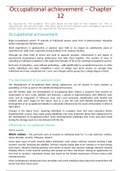Occupational achievement – Chapter
12
As required by the syllabus, this part deals on one part of the chapter 12. This is
required for the second exam. The other parts of that chapter were included in previous
exams and are therefore not required for the third exam.
Occupational achievement
Begin occupational careers majority of individuals pursue some form of postsecondary education
before entering into full-time work.
Work experiences in adolescence, in general, have little or no impact on adolescents’ plans or
aspirations for adult work, especially among students from nonpoor families.
Although we often think of school and work as separate domains, achievement is one aspect of
psychosocial development during adolescence that links them together. The number of years of
schooling an individual completes is the single best indicator of his or her eventual occupational success.
Each year of education—even without graduating— adds significantly to occupational success. In other
words, individuals who have completed 3 years of college earn more money, on average, than
individuals who have completed only 1 year, even though neither group has a college degree in hand.
The development of occupational plans
The development of occupational plans during adolescence can be viewed in many respects as
paralleling, or even as part of, the identity development process.
Just like identity dvpt: the development of occupational plans follows a sequence that involves an
examination of one’s traits, abilities, and interests; a period of experimentation with different work
roles; and an integration of influences from one’s past (primarily, identification with familial role
models) with one’s hopes for the future. And as is also the case with identity development, the
development of an occupational identity is profoundly influenced by the social environment in which it
takes place.
Changes in the labour force, requiring individuals to complete more and more education before
beginning their careers, have made young adulthood a far more important phase than adolescence for
the development of occupational plans. many developmental challenges that in the past were faced
during the teenage years are now delayed until the 20s.
Influences on occupational choices
Work values
Work values = The particular sorts of rewards an individual looks for in a job (extrinsic, intrinsic,
social, altruistic, security, influence, leisure).
Seven basic types of work rewards define individuals’ work values: extrinsic rewards (earning a high
income), security (enjoying job stability), intrinsic rewards (being able to be creative or to learn things
from work), influence (having authority over others or power over decision making), altruistic rewards
(helping others), social rewards (working with people you like), and leisure (having an opportunity for
free time or vacation). Individuals choose jobs based on the relative importance of these various work
rewards to them.
Many contemporary adolescents have unrealistic and overly ambitious ideas about the rewards they will
derive from their future work.






